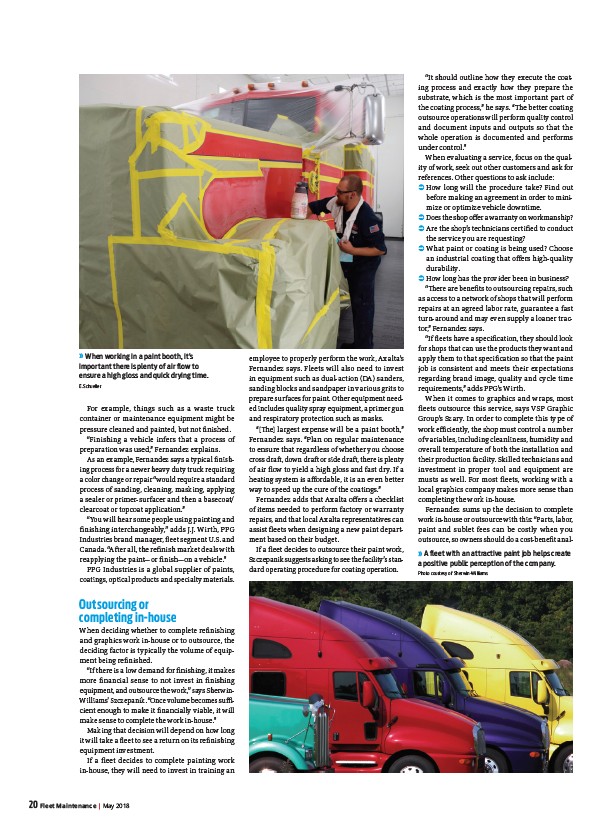
For example, things such as a waste truck
container or maintenance equipment might be
pressure cleaned and painted, but not fi nished.
“Finishing a vehicle infers that a process of
preparation was used,” Fernandez explains.
As an example, Fernandez says a typical fi nishing
process for a newer heavy duty truck requiring
a color change or repair “would require a standard
process of sanding, cleaning, masking, applying
a sealer or primer-surfacer and then a basecoat/
clearcoat or topcoat application.”
“You will hear some people using painting and
fi nishing interchangeably,” adds J.J. Wirth, PPG
Industries brand manager, fl eet segment U.S. and
Canada. “Aft er all, the refi nish market deals with
reapplying the paint—or fi nish—on a vehicle.”
PPG Industries is a global supplier of paints,
coatings, optical products and specialty materials.
Outsourcing or
completing in-house
When deciding whether to complete refi nishing
and graphics work in-house or to outsource, the
deciding factor is typically the volume of equipment
being refi nished.
“If there is a low demand for fi nishing, it makes
more fi nancial sense to not invest in fi nishing
equipment, and outsource the work,” says Sherwin-
Williams’ Szczepanik. “Once volume becomes suffi -
cient enough to make it fi nancially viable, it will
make sense to complete the work in-house.”
Making that decision will depend on how long
it will take a fl eet to see a return on its refi nishing
equipment investment.
If a fl eet decides to complete painting work
in-house, they will need to invest in training an
20 Fleet Maintenance | May 2018
employee to properly perform the work, Axalta’s
Fernandez says. Fleets will also need to invest
in equipment such as dual-action (DA) sanders,
sanding blocks and sandpaper in various grits to
prepare surfaces for paint. Other equipment needed
includes quality spray equipment, a primer gun
and respiratory protection such as masks.
“Th e largest expense will be a paint booth,”
Fernandez says. “Plan on regular maintenance
to ensure that regardless of whether you choose
cross draft , down draft or side draft , there is plenty
of air fl ow to yield a high gloss and fast dry. If a
heating system is aff ordable, it is an even better
way to speed up the cure of the coatings.”
Fernandez adds that Axalta off ers a checklist
of items needed to perform factory or warranty
repairs, and that local Axalta representatives can
assist fl eets when designing a new paint department
based on their budget.
If a fl eet decides to outsource their paint work,
Szczepanik suggests asking to see the facility’s standard
operating procedure for coating operation.
“It should outline how they execute the coating
process and exactly how they prepare the
substrate, which is the most important part of
the coating process,” he says. “Th e better coating
outsource operations will perform quality control
and document inputs and outputs so that the
whole operation is documented and performs
under control.”
When evaluating a service, focus on the quality
of work, seek out other customers and ask for
references. Other questions to ask include:
How long will the procedure take? Find out
before making an agreement in order to minimize
or optimize vehicle downtime.
Does the shop off er a warranty on workmanship?
Are the shop’s technicians certifi ed to conduct
the service you are requesting?
What paint or coating is being used? Choose
an industrial coating that off ers high-quality
durability.
How long has the provider been in business?
“Th ere are benefi ts to outsourcing repairs, such
as access to a network of shops that will perform
repairs at an agreed labor rate, guarantee a fast
turn-around and may even supply a loaner tractor,”
Fernandez says.
“If fl eets have a specifi cation, they should look
for shops that can use the products they want and
apply them to that specifi cation so that the paint
job is consistent and meets their expectations
regarding brand image, quality and cycle time
requirements,” adds PPG’s Wirth.
When it comes to graphics and wraps, most
fl eets outsource this service, says VSP Graphic
Group’s Szary. In order to complete this type of
work effi ciently, the shop must control a number
of variables, including cleanliness, humidity and
overall temperature of both the installation and
their production facility. Skilled technicians and
investment in proper tool and equipment are
musts as well. For most fl eets, working with a
local graphics company makes more sense than
completing the work in-house.
Fernandez sums up the decision to complete
work in-house or outsource with this: “Parts, labor,
paint and sublet fees can be costly when you
outsource, so owners should do a cost-benefi t anal-
» When working in a paint booth, it’s
important there is plenty of air flow to
ensure a high gloss and quick drying time.
E.Schueller
» A fleet with an attractive paint job helps create
a positive public perception of the company.
Photo courtesy of Sherwin-Williams